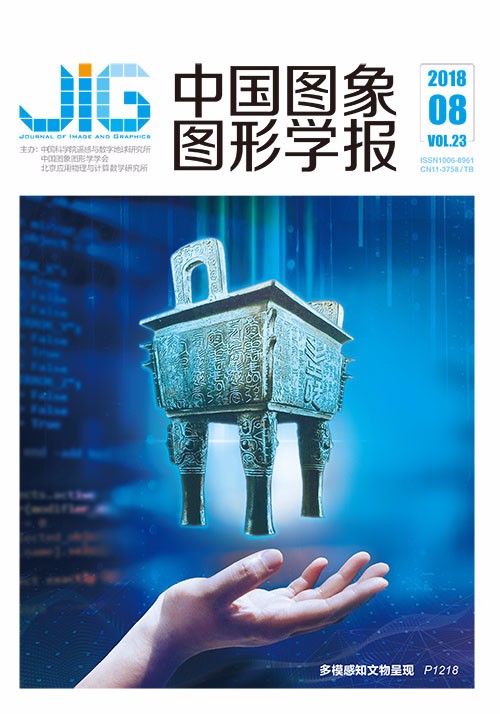
改进特征与GPU加速的行人检测
摘 要
目的 目前行人检测存在特征维度高、检测耗时的问题,行人图像易受到光照、背景、遮挡等影响,给实际行人检测造成了一定困难。为了提高检测准确性,减少检测耗时,针对以上问题,提出一种改进特征与GPU (graphic processing unit)加速的行人检测算法。方法 首先,采用多尺度无缩放思想,通过canny算子对所有样本进行预处理,减少背景干扰与统一归格化的形变影响。然后,针对实际视频中的遮挡问题,把图像分成头部、左臂、上身、右臂、左腿、右腿6个区域。接着选取比LBP (local binary patterns)特征鲁棒性更好的SILTP (scale invariant local ternary pattern)特征作为纹理特征,在GPU空间中并行提取;同时,分别提取6个区域的HOG (histogram of oriented gradient)特征值,结合行人轮廓在6个区域上的梯度方向分布特性,对其进行加权。最后,将提取的全部特征输出到CPU (central processing unit),利用支持向量机(SVM)分类器实现行人检测。结果 在INRIA、NICTA数据集上进行实验,INRIA数据集上检测率达到99.80%,NICTA数据集上检测率达到99.91%,并且INRIA数据集上检测时间加速比达到12.19,NICTA数据集上达到13.49,相对传统HOG、LBP算法,检测率、时间比实现提高。结论 提出的改进HOG-SILTP特征与GPU加速的行人检测算法,能够有效表达行人信息,改善传统特征提取方式带来的耗时与形变影响,对环境变化、遮挡具有较强的鲁棒性。该算法在检测率、检测时间方面均有提高,能够实现有效、快速的行人检测,具有实际意义。
关键词
Pedestrian detection based on improved feature and GPU acceleration
Qi Meibin, Li Ji, Jiang Jianguo, Wang Cichun(School of Computer and Information, Hefei University of Technology, Hefei 230009, China) Abstract
Objective With the growing attention paid to public safety and security, video surveillance systems become increasingly important. Pedestrian detection is the first step in video surveillance systems when analyzing behaviors of pedestrians, so it plays a critical role in computer vision research area. Although pedestrian detection has realized several achievements in recent years, speed and accuracy continue to show rooms for improvement. On the one hand, pedestrian detection is time consuming as it requires extensive calculation and high dimension of features. On the other hand, the detection results are easily influenced by different environmental factors, such as the changes of illumination and background, different postures of pedestrians, and occlusion among pedestrians. As detection results depend on the performances of the feature set and classifier, the features should be adequately representative to distinguish a pedestrian from other objects and background. This study proposes an algorithm for pedestrian detection based on improved feature and graphic processing unit (GPU) acceleration to reduce detection time and improve detection rate. Method First, Canny operator is used to process the original images and obtain images with enhanced edge information. Second, the images are processed in three scales to reduce the interference of background and deformation effect of unified standardized. Third, the images are divided into six regions to address the occlusion problem among pedestrians. These regions are head, left arm, upper body, right arm, left leg, and right leg, which are divided according to the characteristics of pedestrian action. Thereafter, the scale invariant local ternary pattern (SILTP) feature is used instead of the local binary pattern (LBP) feature to improve the pixel of low resolution and varied illuminations of images. The SILTP feature in parallel is extracted as the texture feature in GPU space to reduce the time of calculation. At the same time, the gradient and amplitude information of the six regions is calculated in the GPU space, and the value of the gradient is weighed with the value of the distribution characteristics. Therefore, the improved histogram of oriented gradient (HOG) features with 180 dimensions are obtained. The dimensions are much lower compared with traditional HOG feature and the calculation time is reduced. Finally, the features extracted in the three scales is concatenated, including HOG and SILTP feature. All features are outputted to central processing unit (CPU) space from GPU space, achieving pedestrian detection by the linear support vector machine (SVM) classifier. Result The proposed algorithm is demonstrated on two datasets, namely, INRIA and NICTA. The INRIA dataset is presently the most widely used static pedestrian dataset. The backgrounds, pedestrians' postures, and occlusions among pedestrians in this dataset are complex. By contrast, the NICTA dataset contains a large number of pedestrian images in different sizes. Therefore, the detection results of INRIA and NICTA datasets are representative. The INRIA dataset contains 2 416 positive training and 1 218 negative training samples and 1 126 positive detecting and 453 negative detecting samples. The NICTA dataset contains 142 598 positive training and 90 605 negative training samples and 34 416 positive detecting and 42800 negative detecting samples. The proposed method achieves a detection rate of 99.80% and 99.91% on INRIA dataset and NICTA dataset, respectively. On the INRIA dataset, the acceleration ratio is 12.19 compared with the algorithm based on traditional HOG and LBP, and the acceleration ratio of feature extraction is more than 8.19. On the NICTA dataset, the acceleration ratio is 13.49 compared with the algorithm based on traditional HOG and LBP. Therefore, the proposed algorithm based on improved feature and GPU acceleration enhances the detection rate and reduces the detection time. Conclusion Experiment results show that the proposed algorithm based on improved feature and GPU acceleration perform better than other algorithms in terms of accuracy and speed. The improved feature exhibits strong robustness to the changes of illumination and environment and performs well despite the occlusion among pedestrians. Apart from its lower dimension which improves the speed of pedestrian detection, the algorithm provides accurate information on pedestrians. The proposed algorithm is suitable for most situations involving pedestrian detection, especially for images or videos in an environment with different illuminations and occlusions. Its speed also performs well, especially with large amount of calculation and high repeatability. The proposed algorithm based on improved feature and GPU acceleration can achieve effective and fast pedestrian detection and has practical value.
Keywords
pedestrian detection graphic processing unit(GPU) acceleration scale invariant local ternary pattern (SILTP)feature histogram of oriented gradient(HOG) feature support vector machine( SVM) classifier
|



 中国图象图形学报 │ 京ICP备05080539号-4 │ 本系统由
中国图象图形学报 │ 京ICP备05080539号-4 │ 本系统由